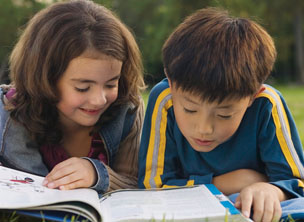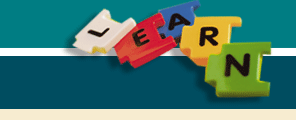|
 |
|
From Compliance to Quality:
How to Make Evaluation Work for
Your Program
Evaluation. If you work in afterschool, you probably hear the word
with great frequency. Many afterschool programs are required to evaluate
their program or bring in an external evaluator to review their work
and determine if the program is in compliance with the terms of the
grant.
Although it’s a start, simply completing an evaluation does
not ensure a high-quality program. As we at the National
Partnership for Quality Afterschool Learning continue our research and training,
we urge afterschool professionals to think beyond using an evaluation
to show compliance to using it to build high-quality, sustainable
afterschool programs. High-quality programs have clear program goals,
undergo regular evaluations to determine if they are meeting program
goals, and reset their goals based on these evaluations.
Program evaluation is too broad of a topic to cover in one newsletter
(we’ll cover other aspects of this topic in April), but we
hope to steer you toward some guidelines, resources, and examples
that will change your view of program evaluation from a report completed
every year to secure funding to an incredible tool that will set
your program in a pattern of continuous improvement. The steps below
will help ensure that you get the most out of a program evaluation.
- Plan early
- Decide what you want to know about your program
- Get all of the stakeholders involved
- Use what you learn
Learn more >> |
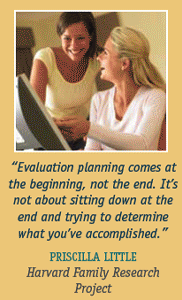

|
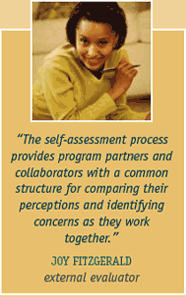
|

Colorado 21st Century Community Learning Centers
Even the process of developing evaluation tools can involve
monitoring your work and using results for continuous improvement.
Just ask the team that developed the evaluation
tools for the Colorado 21st Century Community Learning Centers (21st CCLCs).
The evaluation includes progress reports to determine continued
funding, the 21st CCLC Profile and Performance Information Collection
System that all 21st CCLC grantees are required to complete,
a quality improvement/monitoring tool, and focus groups.
Launched this year, the quality improvement/monitoring
section is the newest component of the evaluation structure.
In developing the tool, the team sought input from afterschool
staff, program evaluators, afterschool advisors, and outside
experts. While they were working on the various drafts of the
tool, evaluation leaders also presented it to grantees, giving
them the opportunity to provide feedback and express any concerns
they had. Finally, they pilot-tested the tool at three sites.
According to Joy Fitzgerald, an external evaluator who helped
develop the tool, “The
feedback of those who participated in the pilot monitoring
visits was invaluable in helping us fine-tune both the format
of the . . . tool and the processes for its use by programs and
monitoring teams.”
|
|
|
 |
LA's BEST
los angeles, CA
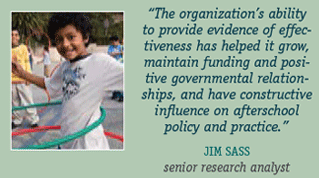
Photo courtesy of LA's BEST
When
the word best is part of your name, people expect great things from
your afterschool programs. To ensure that they are living up to their
name, the staff at LA’s BEST (Better Educated Students for
Tomorrow), an afterschool enrichment program that offers out-of-school
activities for elementary students at 180 sites across Los Angeles,
California, have included evaluation in their program administration
since the organization was created in 1988.
LA’s BEST has relied on external evaluations,
such as a recently completed 4-year study, which found that students
who participated in the program for 3 or more years were 20% less
likely to drop out of school than their peers. Senior educational
research analyst Jim Sass notes that the organization’s ability
to provide evidence of effectiveness has helped it “grow, maintain
funding and positive governmental relationships, and have constructive
influence on afterschool policy and practice.”
|
|
|
|
 |
Presenting Evaluation Results
If you are eager to show off results of an evaluation, remember
not to limit your report to data. Include some narrative
description of the program and its best practices, as well
as quotes from students and photographs of some of your
afterschool activities. Including this qualitative information
will help you reach a broader audience.
Do you have a training tip you
would like to share? E-mail us at
afterwords@sedl.org with “Training
tip”
in the subject line.
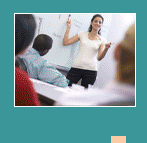
|
|
|
|
|
Questions or comments should be directed to:
Laura Shankland
SEDL
211 E. 7th St., Suite 200
Austin, TX 78701-3253
Phone: 800-476-6861 ext. 237
Fax: 512-476-2286
E-mail: afterwords@sedl.org
Unsubscribe
from this list |
Copyright © 2007 by SEDL . This newsletter was produced
in whole or in part with funds from the U.S. Department of Education
under contract number ED-01-CO-0057/0001.
You are welcome to reproduce AfterWords and distribute
copies at no cost to recipients; please credit SEDL as publisher. If you are having trouble viewing
this newsletter, please view
it online.
|
|
|


